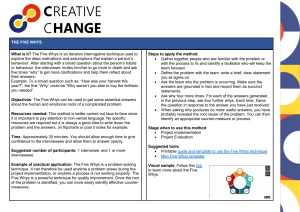Five Whys
What is it? The Five Whys is an iterative interrogative technique used to explore the deep motivations and assumptions that explain a person’s behaviour. After starting with a broad question about the person’s habits or behaviour, the interviewer invites him/her to go more in depth and ask five times “why” to get more clarifications and help them reflect about their answers.
Example: To a broad question such as: “How was your harvest this year?”, the first “Why” could be “Why weren’t you able to buy the fertilizer you needed”.
Objectives: The Five Whys can be used to get some essential answers about the human and emotional roots of a complicated problem.
Resources needed: This method is better carried out face-to-face since it is important to pay attention to non-verbal language. No specific resources are required but it is always a good idea to write down the problem and the answers, on flipcharts or post it notes for example.
Time: Approximately 30 minutes. You should allow enough time to give confidence to the interviewees and allow them to answer openly.
Suggested number of participants: 1 interviewer and 1 or more interviewees.
Example of practical application: The Five Whys is a problem-solving technique. It can therefore be used anytime a problem arises during the project implementation, or anytime a process is not working properly. The Five Whys is a powerful technique for quality improvement. Once the root of the problem is identified, you can more easily identify effective counter-measures.
Steps to apply the method:
- Gather together people who are familiar with the problem or with the process to fix and identify a facilitator who will keep the team focused.
- Define the problem with the team: write a brief, clear statement you all agree on.
- Ask the team why the problem is occurring. Make sure the answers are grounded in fact and record them as succinct statements.
- Ask why four more times. For each of the answers generated in the previous step, ask four further whys. Each time, frame the question in response to the answer you have just received.
- When asking why produces no more useful answers, you have probably revealed the root cause of the problem. You can then identify an appropriate counter-measure or process.
Stage when to use this method:
- Project implementation
- Project Evaluation
Suggested tools:
Visual sample: Follow this link to learn more about the Five Whys.


